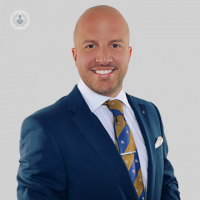P-Shocks: Non-surgical treatment for Peyronie's Disease
Written by:Peyronie’s disease is a condition that causes the penis to bend when it’s erect. Whilst a curved erection isn’t usually a health concern, a significantly bent penis can be distressing, causing pain or difficulties during sex.
To treat this, some people may choose to undertake Dr Fabio Castiglione’s P-Shocks treatment, an advanced, non-surgical, method for the cure of Peyronie’s curvature. Here, the renowned consultant urologist andrologist, provides an expert insight into the treatment.

What is Peyronie's disease?
Peyronie’s disease is a scarring condition distinguished by the creation of a fibrous scar (plaque) on the tunica albuginea, one of the penis envelopes. This scar may produce a penile curvature and possibly, impotence.
To understand how this is produced, imagine having a scar on the hand. Scar tissue is rigid and challenges movement, and thus, having a scar on the hand prevents normal bending or extension. A similar phenomenon occurs in Peyronie’s disease, where the scar in the tunica albuginea limits the extension of the penis, causing a bend.
What is involved in the P-Shocks treatment?
P-Shocks is the name for the multi-modal protocol strategy that makes up the effective non-surgical treatment for Peyronie’s disease.
It consists of five components:
- Activation of nitric oxide production, leading to a reduction in fibrosis
- Shockwave therapy that is utilised to make the fibrotic plaque more malleable
- Regular use of a penile pump to achieve scar remodelling
- A microneedling treatment for the penile plaque
- Injection of platelet-rich plasma (known as PRP) into the plaque to ameliorate wound healing
What is the exact role of nitric oxide?
Nitric oxide is a gas and a neurotransmitter that plays a significant role in the maintenance of health. Its primary purpose is vasodilation, which refers to the process that causes the arteries to expand, making it possible for more blood to flow to the organs and tissues.
Vasodilation apart, nitric oxide also serves a number of other extremely vital roles in our bodies, including - first and foremost - the regulation of the healing process as well as the immune system. In fact, the production of collagen and fibrosis can both be slowed down by the presence of nitric oxide. Another essential process is angiogenesis, sometimes known as the formation of new blood vessels, which takes place throughout the process of natural cell death (apoptosis).
On Peyronie’s disease, nitric oxide is a fundamental component of an erection. It does this by relaxing the smooth muscle cells of the penis that are located in the corpus cavernosum (the columns of spongy erectile tissue) which in turn, results in an erection. Nitric oxide has a number of other impacts, but its antifibrotic effect is one of the most important ones.
How is Peyronie’s disease managed with the P-Shocks treatment? How effective is this?
The P-Shocks treatment reduces the fibrosis of Peyronie’s disease. It does this in five different ways:
1. Increased production of nitric oxide
P-Shocks includes a crucial step that calls for an increase in its output. It does this by boosting the total quantity of nitric oxide particles, which in turn magnifies or broadens their impact.
2. Elimination or lessening of fibrosis
This is accomplished by combining the use of a medicine that is a PDE5i (which is a chemical that is analogous to Viagra), with the use of the natural supplements of l-citrulline, an amino acid that is consumed on a daily basis in conjunction with meals.
3. Use of shockwave treatment
Shockwaves are utilised in P-Shocks to break up the scar tissue created in Peyronie’s disease. This then restores the plaque to an inflammatory state that is more flexible and softer than the state that forms the penile curvature. Revascularisation is another extremely significant consequence of shockwaves, and it is one that can contribute to improved erections.
4. Use of microneedling
Microneedling, which has been applied in the scar field for a number of years at this point, is an approach that is capable of efficiently treating scars. It comprises producing very small punctures (sometimes known as micro-punctures) in the penile plaque, which helps to break up any existing scar tissue and encourages the synthesis of new collagen and elastin.
5. Use of platelet-rich plasma
Platelet-rich plasma is made from ordinary plasma that has a higher number of platelets per unit of plasma than what is found in regular blood. When activated, platelet-rich plasma causes a cascade of chemicals and growth factors to be released into the penis' tissue. This has been theorised to aid in new vessel formation and the reduction of fibrosis.
6. Reorganisation of the fibrotic plaque
At this point in the process, P-Shocks calls for the remodelling of the fibrotic plaque with the goal of ensuring that the plaque is able to fully relax. This is accomplished using a penis pump instrument.
With a penis pump, a vacuum is created inside of a tube. This allows blood to enter the penis, which in turn, stimulates an erection. The penis is unable to fold inside of the vacuum.
Due to the varying diameters, the vacuum also makes it possible for the penis to be reshaped. This will begin with larger-diameter cylinder vacuums and work its way down to smaller-diameter cylinder vacuums until the penis is almost entirely straight. The amount of the initial curvature is the only factor that determines whether or not the treatment may be carried out.
The P-Shocks treatment is the most efficient, non-invasive, option for Peyronie’s disease and impotence at the moment.
Dr Fabio Castiglione is a widely experienced consultant urologist andrologist who specialises in all aspects of erectile dysfunction. If you are considering the P-Shocks treatment for Peyronie’s disease, and wish to consult your options with an expert, do not hesitate to visit Dr Castiglione’s Top Doctors profile today.


